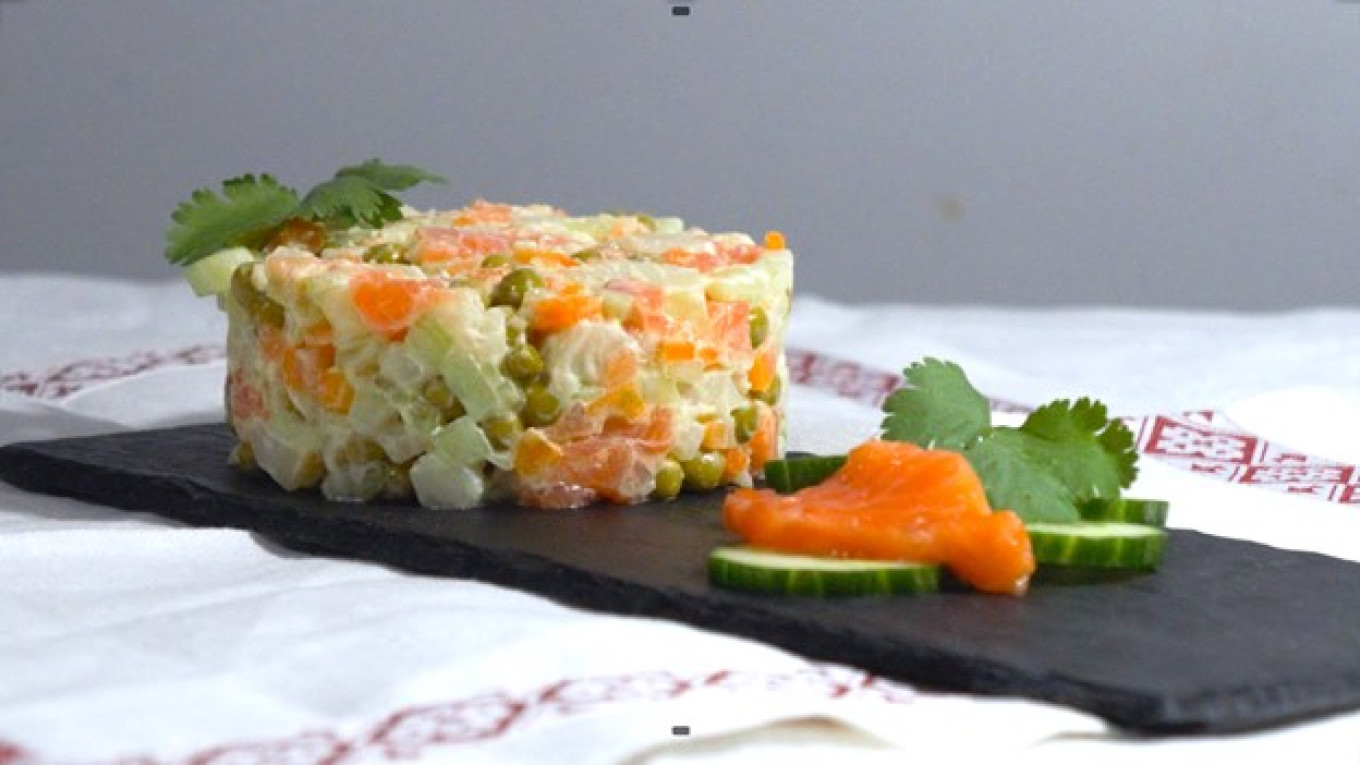Like many Russians in and outside of Russia, we can’t imagine New Year’s without Salad Olivier. It was made in our parents’ homes a half-century ago, and we’ve been making it ourselves for as long as we can remember. We’re sure that our children and grandchildren will also serve this immortal salad, too.
Some people believe that we all have a genetic memory, including in food. Scientists say that we are likely to like to eat what our ancestors ate. There is an ounce of truth in this. For example, few foreigners like kvass or sauerkraut as much as natives of Russia do. But Olivier is the great exception to this rule.
For example, there are videos of, say, Italians trying Russian food — kholodets (meat jelly), herring under a fur coat, a soup called okroshka. "Never again" is the most polite response from the tasters. But Salad Olivier is something else. In Spain and a few other countries it’s called “Russian salad.” And people like it all over the world.
For us, Salad Olivier on the table is like Pushkin in poetry. You might not love it madly, but you wouldn’t say a bad word about it in public. Real Russians eat Salad Olivier!
But it is not a traditional and ancient Russian dish. There were no mixed salads, especially with mayonnaise, in Russian cuisine in 200 years ago. In fact the word "mayonnaise" came to Russia at the end of the 18th century, and it isn’t what you think it is.

Today mayonnaise is a sauce made of whipped egg yolks, lemon juice, and vegetable oil. But imagine a rich St. Petersburg home at the end of the 18th century. In keeping with the fashion of the times, they hired a French chef and brought in serf boys as his assistants. They grew up in the kitchens doing whatever needed to be done. Some became chefs themselves while others were freed by their owners to start careers in taverns. But in their new jobs they remembered how a French chef would create a dish made of pieces of turkey or filet of boiled fish, garnished with a macédoine of cooked vegetables and a white sauce, and call it "Mayonnaise!"
So in Russian cookbooks of the 19th century "mayonnaise" meant pieces of game or fish served with roasted or pickled vegetables and mayonnaise sauce. Actually, you can find dishes like this called “mayonnaise” in some foreign cookbooks as well.
Mayonnaise in those years was not today’s homemade or purchased condiment. Today in most cases mayonnaise is Provençal — a sauce made from Provençal oil, egg yolks, vinegar, mustard, salt, sugar and pepper. The concept of "mayonnaise" was more complicated. One recipe included lanspig — meat or fish aspic cut into cubes.
Salad Olivier was this kind of "mayonnaise." Invented in the 1860s by chef Lucien Olivier, it was originally called "wild game mayonnaise" and was very popular with Moscow gourmets.

We all know that Salad Olivier was invented by a French chef, but what do we know about him?
We actually know very little. We know that he was a second-generation Frenchman (or possibly Belgian) in a family that had emigrated to Russia. And we know that he never worked as a chef. Olivier was a co-founder of the Hermitage restaurant in Moscow, where this salad was served, and an amateur cook. But he was not a famous French chef. In fact, he might not have been Lucien Olivier. Some sources indicated that before he became a restaurateur Olivier was called Nikolai, and he took the sonorous French name for "public relations purposes," we would say today.
A few years ago, the last page of his history was discovered. In Crimea local historians were studying the parish book of the St. John Chrysostom Church in Yalta when they found the record that on November 14, 1883, at age 45 "Lucien Olivier, a French citizen, a Catholic, died from a heart defect.” His body was brought to Moscow and buried in the Vvedensky cemetery.
The same veil of mystery shrouds the salad itself. There is almost no authentic information about the original recipe. Some versions of this dish were described in the press of the era, for example, in the magazine "Our Food" in 1894. The first detailed description of the salad was the recipe in the book by Pelagia Alexandrova-Ignatieva " Practical Guide of the Basics of Culinary Arts " (1899). It was packed with flavor: grouse, crawfish, olives... It was even dressed with the now forgotten Kabul sauce, made of boiled and then pureed soybeans mixed with cayenne pepper, broth, and vinegar.

During the Soviet era many legends appeared about mayonnaise and Salad Olivier. For a long time everyone believed that the Soviet version of Salad Olivier — called Stolichny (Capital) Salad — was invented in the 1930s by a certain chef Ivanov, who in his youth worked under Lucien Olivier himself. The problem with this story was that Ivanov had to be at least 70 years old when he invented it. In 2013 we reconstructed the real history of the Stolichny salad and published it in the book "The True History of Soviet Cuisine.” We spoke to a direct witness to the events, the former chief chef of Moscow, Sergei Protopopov. He told us that the idea for the "new Soviet Olivier" came from Grigory Yermilin, head chef at the Moscow Hotel restaurant. Naturally, this relatively young chef — about 30 years old — did not know Lucien Olivier.
But the adventures of Salad Olivier did not end there. In the 1950s it was officially called Salad Stolichny (Capital Salad). Along with the change in name came a slight change in ingredients. For example, the grouse could be replaced by chicken. The recipe was simplified to include boiled chicken, potatoes, carrots, fresh and pickled cucumbers and eggs.
In the 1970s, a version appeared made with a Soviet version of baloney (докторская колбаса). This was called Moscow Salad, and home cooks began to make buckets of the dish for holidays. Over the next decades people continued to experiment, for example, by adding diced apples. Many cooks continue to make the dish this way today.

Salad Olivier is as popular as ever. On New Year's Eve, many home chefs will pay tribute to tradition and put their favorite salad on the table. But now they give free rein to their imaginations, mixing the ingredients in beautiful ways or adding something new and unexpected. They might serve it as “Olivier rolls” or even make a foamy "Molecular Olivier."
We like to keep up with the times, too, and so are making our Salad Olivier with lightly salted red fish rather than boiled chicken. Salmon is best, but you can used salted trout, too.
Salad Olivier
For five to six portions
Ingredients
- 2 potatoes
- 2 fresh cucumbers
- 1 medium carrot
- 100 g (3/4 c or 3.5 oz) green peas
- 150 g (about 5.3 oz or I c) lightly salted salmon
- 3 Tbsp mayonnaise
- salt to taste
Instructions
- Boil the carrots and potatoes in jackets; when ready cool thoroughly.
- Peel the cucumbers and vegetables.
- Dice the potatoes, carrots, cucumbers and salmon -into very small cubes — about 2/10 of an inch.
- Add green peas and mix carefully with mayonnaise. When all the ingredients are well mixed, place in serving bowl or food rings.
A Message from The Moscow Times:
Dear readers,
We are facing unprecedented challenges. Russia's Prosecutor General's Office has designated The Moscow Times as an "undesirable" organization, criminalizing our work and putting our staff at risk of prosecution. This follows our earlier unjust labeling as a "foreign agent."
These actions are direct attempts to silence independent journalism in Russia. The authorities claim our work "discredits the decisions of the Russian leadership." We see things differently: we strive to provide accurate, unbiased reporting on Russia.
We, the journalists of The Moscow Times, refuse to be silenced. But to continue our work, we need your help.
Your support, no matter how small, makes a world of difference. If you can, please support us monthly starting from just $2. It's quick to set up, and every contribution makes a significant impact.
By supporting The Moscow Times, you're defending open, independent journalism in the face of repression. Thank you for standing with us.
Remind me later.







